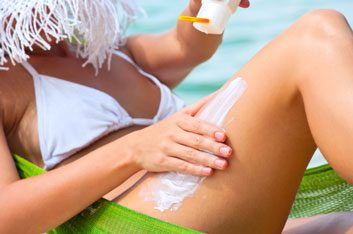Are you using the right sunscreen?
Sunscreen labels can be complicated. Here’s how to know if you’re getting enough sun protection

Source: Best Health Magazine, Summer 2011
Skin cancer is the most common form of cancer in Canada, and those with fair skin are at increased risk. ‘Exposure to ultraviolet radiation from the sun or indoor tanning equipment and having fair skin are the most common risk factors for skin cancer,’ says Lynda MacNiven, senior prevention coordinator for the Canadian Cancer Society, Ontario Division. ‘People who work, or exercise, in the sun for long periods of time are at greater risk.’
Basal cell and squamous cell cancers are common and not usually life-threatening. The Canadian Cancer Society estimates there will be about 74,100 new cases of non-melanoma skin cancer this year in Canada, and about 270 deaths. Melanoma, the most deadly type of skin cancer, will strike 5,500 Canadians in 2011, and cause 950 deaths. Exposure to the sun and having fair skin are risk factors for melanoma, but the causes are not yet well-understood. People sometimes develop melanoma without sun exposure.
Label reading and UVA
Safe-sun messages are straightforward: Wear protective clothing and a hat, stay out of the sun between 11 a.m. and 4 p.m., and seek shade. And, of course, wear sunscreen. But the science is more complicated. Two wavelengths of ultraviolet light affect human skin. UVB rays (the shorter rays) burn the skin, causing redness, and also predispose us to skin cancer. UVB is most intense in the summer. UVA rays account for 95 percent of the sun’s rays, and not only that, their intensity changes little throughout the year. Plus, they can penetrate through windows.
Says Montreal dermatologist Dr. Alfred Balbul: ‘We now know UVA penetrates deeper, causing quicker aging of the skin’that mottled sunburn look’over the years. It has also been shown to cause DNA modifications, which increases the cancer risk.’
SPF refers to a product’s ability to protect against UVB rays only. The Canadian Dermatology Association recommends an SPF of at least 30, which protects against 97 percent of UVB rays. An SPF 50 provides 98 percent protection. You can buy 110, but according to Balbul, ‘higher than 60 gives little additional benefit.’ No sunscreen product offers complete protection; only staying in the shade can do that.
So what protects us from UVA rays? You can look for labels that say ‘broad spectrum’ or ‘UVA/UVB,’ which means it contains some UVA protection. The problem is, that doesn’t tell us how well it protects. Says Stéphane Shank, a spokesperson at Health Canada, ‘Currently, Health Canada is assessing a number of initiatives, including improved labelling of UVA protection.’
In the meantime, the ingredients list on a product might help you. Dr. Steven Wang, director of dermatological surgery and dermatology at Memorial Sloan-Kettering Cancer Center in New York City, recommends products containing zinc oxide; avobenzone plus octocrylene (you need both together); ecamsule (Mexoryl SX); or any combination of these ingredients. And titanium dioxide also helps: Like zinc oxide, it actually blocks the rays. Balbul suggests looking for the Canadian Dermatology Association logo on the bottle or tube. This means it contains some UVA protection, has SPF of 30 or higher, and is non-irritating.
How much do you need?
You’ve probably heard that you should apply the equivalent of a shot glass of sunscreen‘but shot glasses can vary in size. Many experts use the guideline of at least two tablespoons (30 mL) for the entire body, and it should be applied 30 minutes before going outside. But do you put it on before or after your facial moisturizer and body lotion? Say Balbul and Wang, sunscreen should go on before moisturizer. (In fact, says Balbul, a good sunscreen should be all you need in summer.) But the main thing is to put it on.
And moisturizer that contains sunscreen isn’t enough, warns Wang. In a study published this year in the Archives of Dermatology, he and colleagues tested 29 moisturizers with an SPF of 15 to 50 to see if they protected against UVA. Most did not offer sufficient UVA protection.
The future of sunscreens
Sunscreens may one day be required to provide a minimum level of UVA protection, or include a UVA rating system on their labels. Craig Sinclair, chair of the Cancer Council in Australia (where skin cancer is very prevalent), says sunscreen would ideally balance UVA and UVB protection. ‘You want 1:1. This is difficult to achieve for largely cosmetic reasons, but it’s what we need to aim for.’
In Europe, sunscreen labels include a standardized logo (a circle with ‘UVA’ inside it) that tells consumers the product offers a minimum UVA protection rating in proportion to its SPF rating (1:3 ratio). In the U.S., the FDA has proposed a star-rating system, with four stars being the highest UVA protection. It hasn’t yet been passed into law.
This article was originally titled "Ultra-violent rays" in the Summer 2011 issue of Best Health. Subscribe today to get the full Best Health experience’and never miss an issue!




